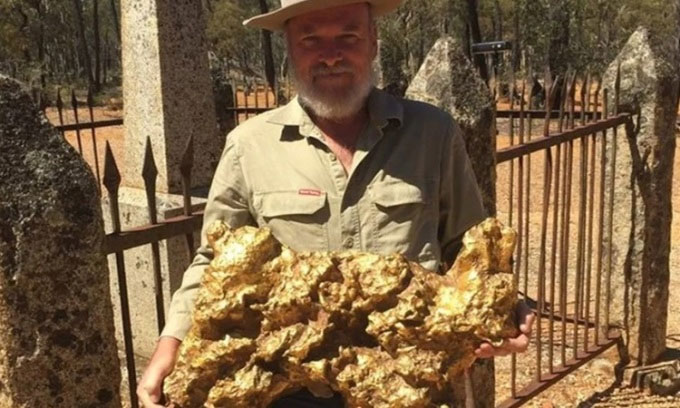The block of gold is more than 72kg, the world's largest ever found
The block of gold found by two British people more than 100 years ago in Victoria weighs 72kg, is 0.6 meters long and nearly 0.3 meters wide.
In February 1869, two British prospectors John Deason and Richard Oates dug for gold in central Victoria, Australia. There, their pickaxe hit a hard object very close to the ground. When Deason squatted to examine the large rock blocking the path, he discovered it was a giant block of gold . This is the largest block of gold ever found, 0.6 meters long and nearly 0.3 meters wide, according to Interesting Engineering .

Expert John Tully holds a replica of the "Welcome Stranger" gold block. (Photo:Rachel Buckley)
Deason and Oates were excited, but they had to hide the gold safely before announcing it. They waited until the Sun went down. In the dark, Deason and Oates dug up the gold and brought it back to Deason's tent. They placed it on a fire to burn off all the dirt and break the black quartz covering the gold block. The gold block was smoked all weekend and on Monday morning, about 31.8 kg of black quartz broken from the gold block was taken to a local ore crusher for processing, helping to collect 1.7kg of gold. The remaining block of gold was taken to the town of Dunolly 14.5km away.
At Dunolly, Deason and Oates took the gold straight to the bank to avoid being robbed. However, the block of gold named "Welcome Stranger" was too large to be placed on the bank scale, so it had to be wheelbarrowed to a local blacksmith to be divided into three blocks. Deason and Oates sold 66kg of gold to the bank, and kept the rest as their own. There are many different reports about the weight of the block of gold, but the most common figure is 72kg.
The bank paid £9,563 for the gold bought back. According to John Tully, president of the Goldfields Art Historical Society in Dunolly, that amount is equivalent to the average worker's salary for 43 years. After the discovery, Deason continued to dig for gold and became a store manager in Moliagal. He lost most of his wealth due to failed investments. Deason bought a small farm near Moliagal and spent his last days as a farmer. Meanwhile, Oates returned to England and got married. He returned to Australia, had four children and lived on a 324-hectare farm until his death.
During the Victorian gold rush , Moliagul was a thriving town of 16,000 residents. Today, the community here mainly farms with sparsely populated houses, but gold prospectors still flock to the area called the Golden Triangle . This 9,400km2 area provides some of the world's largest blocks of gold. At a location called Canadian Gully in Ballarat, miners found three large blocks of gold weighing 61kg, 42kg and 38kg respectively in 1853. 18 months later, a group of 9 miners found the Lady Hotham gold block weighing 44kg. Then, in 1858, a 69kg block of gold nicknamed "Welcome Nugget" was also discovered in Ballarat. Up to now, this is still the second largest block of gold in the world. According to authorities, more than 1,300 blocks of gold weighing 500g or more were dug from Victoria gold mine , of which 400 blocks weighed more than 2.8 kg.
In Victoria, most of the underground gold is in quartz reefs . Formed 400 million years ago, these hard gold-bearing quartz reefs can stretch for kilometers but are less than a meter wide, lying steeply underground. Places where quartz reefs protrude from the ground are very difficult to find. But if they are lucky enough to find a new reef, gold detectorists can follow a long stretch above ground and underground. However, the deeper miners dig, the greater the risk of collapse or other disaster.
Many mining companies around the world flocked to Victoria, hoping modern technology could help them discover and mine more pure gold. Modern mines operate based on an understanding of how rocks form and how the Earth's outer crust deforms during tectonic plate shifts. Thanks to that, companies can predict the 3-dimensional shape of gold-bearing quartz reefs, making it easier to locate them deeper underground. Today's drilling method allows rock samples to be taken using machines such as giant core drills. Currently, Victoria's gold mines produce approximately 18,427kg of gold per year.
- Close-up of a huge 10kg gold block found in Alaska
- Australian man dug 4kg gold block
- English: Found the largest natural gold bureau after 500 years, cost 1.5 billion
- Find the world's largest monolithic gold ingot in Russia
- Small gold is super expensive
- China discovered 470 tons of gold on the seabed
- The most gold reserves in the world
- Found the biggest building block of life, about to land on a new planet
- Excavation, accidentally found the largest 1,400-year-old gold treasure in England
- The world's 10 largest gold producers
- Israel: Found 6kg of ancient gold coins in the sea
- Discover the largest gold vault in the UK
 'Fine laughs' - Scary and painful torture in ancient times
'Fine laughs' - Scary and painful torture in ancient times The sequence of numbers 142857 of the Egyptian pyramids is known as the strangest number in the world - Why?
The sequence of numbers 142857 of the Egyptian pyramids is known as the strangest number in the world - Why? History of the iron
History of the iron What is alum?
What is alum?